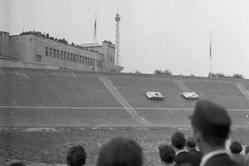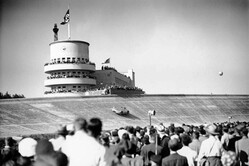 Bernie has thrown out the idea of running Grands Prix as two races, each about 40 minutes long.
Bernie has thrown out the idea of running Grands Prix as two races, each about 40 minutes long.
The stated intention is to improve the show, but it may have been Bernie preparing the way to have standing start resumption of races after a safety car period. There is, however, a precedent for running a Grand Prix in two heats: the 1959 German GP, run on the Avus track in Berlin.
Avus originally consisted of two tight corners and two straights, each nearly six miles long, and in 1926 it was the venue of the first German GP, won by Rudolf Caracciola, the first of six German GPs he won. The following year the race was held at the new Nurburgring but Avus held races for Grand Prix cars, 1931-35. Racing was then suspended while the flat northern corner was replaced with a massive, steep, banking.
It was built to showcase the sheer speed of Auto Union and Mercedes-Benz Grand Prix cars. The 1937 Avusrennen (lower right) was run to Formula Libre. The Grand Prix formula cars had to have a dry weight of no more than 750 kgs, for this race, however, they were allowed streamlined bodies, which added weight.
During practice Luigi Fagioli (Auto Union C Type) set a lap at 174 mph, the fastest speed for a single lap until the 1971 Indianapolis 500. The race itself was run in two heats, with the winner decided on aggregate times. That was Hermann Lang (Mercedes-Benz W25) at an average of speed 162.063 mph.
The reason why the race was run in two heats was tyres, everyone was running on skinny crossplies. The 1937 Avusrennen was a propaganda exercise by the German government which did not want blow outs.
 Avus was used for the 1959 German GP, though the two straights were half their original length since they had run into what had become the Russian Zone of Berlin. If Avus seems an odd choice, bearing in mind that the 'Ring was available, it was against the background of the 1957 and 1958 'Monzanapolis' events, The Race of Two Worlds. These had invited Indycars to run at Monza on the bankings and were an attempt to bring together American and European traditions.
Avus was used for the 1959 German GP, though the two straights were half their original length since they had run into what had become the Russian Zone of Berlin. If Avus seems an odd choice, bearing in mind that the 'Ring was available, it was against the background of the 1957 and 1958 'Monzanapolis' events, The Race of Two Worlds. These had invited Indycars to run at Monza on the bankings and were an attempt to bring together American and European traditions.
In 1957 the European opposition consisted of three Ecurie Ecosse Jaguar D-types, two of them fresh from a 1-2 at Le Mans. The Europeans made more of an effort in 1958, but the Yanks still won and the winning speed of Jim Rathmann (Watson-Offenhauser) of 166.720 mph finally beat Hermann Lang's 1937 race record. For reference, the winner of the 1958 Indianapolis 500 averaged 133.791 mph.
The bankings at Monza, rough and bumpy as they were, had also been incorporated into the Italian GP. At the time, race organisers had a free hand, the FIA did not inspect circuits. Banked circuits produced headline speeds and organisers needed spectators.
Avus gave spectators a chance to see cars more often than once every eight or nine minutes, which was the case at the Nurburgring, and there were also political considerations. Berlin was a divided city, though the wall had yet to be built. West Germany was flourishing, while the East was not. Holding a World Championship race in the city, was an exercise in propaganda, especially since much of the Russian Zone could hear the race.
The 1959 German GP was run in two 30-lap heats, each roughly 155 miles long. It was run in heats in the interest of safety, so that nobody would try to stretch the life of their tyres. Cooper and Lotus had begun to swell the grids and both used bolt-on alloy wheels which were fine for most circuits.
Tony Brooks led a Ferrari 1-2-3 from Dan Gurney and Phil Hill. Fourth place finisher was a lap down, fifth was two laps down and sixth four laps down and they were the only finishers. The front-engined Ferraris had a power advantage and the strength of their relatively heavy chassis was an advantage at Avus and Monza, but nowhere else.
The Avus experiment was not repeated and the 1959 German GP remains the only World Championship race run in heats intentionally. The recent Brazilian GP was run in three parts, having twice been red-flagged, but that was responding to circumstance.
Many things have changed since 1959. Today, there could not be much of a gap between the two heats, bearing in mind the demands of television. Tyre stops are now integral, yet the idea of heats was to allow for fresh tyres and for the teams to do what they wanted to the cars in the interval.
Bernie has floated the idea of two shorter races and it is not clear whether he has a radical new idea or is just talking about an interrupted race. If he means an interrupted race, that is mere gimmickry and would not fool the public for a moment. If he means two separate races, that is another matter.
If there are separate races then the teams should be allowed to work on the cars in the short interval. That would affect the strategy of a driver who had sustained, say, damage to the front wing in race #1. A change in weather conditions might make it advantageous to alter suspension settings.
Pit stops have been mandated in order to spice up the show and running two races need not affect the principle. Indeed, it opens new possibilities.
GP2 and GP3 are each run as two independent races. Qualifying decides the grid for the first race and finishing in that determines the grid for the second, with the gimmick that top eight finishers begin in reverse order in the second, shorter, race. It is, however a gimmick and Formula One surely calls for a more pure form if it is to live up its claim of being the ultimate in motor racing.
If the grid for the second F1 race is determined on the finishing order of the first, then we have merely an interrupted race. A more interesting scenario would be for the grid in race #2 to be determined by the fastest laps set in the first race. Imagine that Harry Hotshoe has been involved in an incident in the first race and has been demoted to the back of the field. He could still set pole for the second race.
If the races are separate yet connected, there would need to be a different points system and this would be of particular concern to constructors. In 1959, there was not a Constructors' Championship though, the previous year a Constructors' Cup had been instigated, but that was all it was, a cup, a trophy, there was no money involved.
For much of 2016, Manor had led Sauber, but that changed at Interlagos and the financial implications for both teams is immense. It is possible to envisage some interesting strategies among the less competitive teams, like sacrificing a finish in the second race in order to earn points or position in the first. Fuel economy is still an issue.
Even if the races are run separately, and there is a points system for each, there still has to be an overall winner. The public demands it. There are two basic ways of achieving this, either aggregate times or the finishing positions in each of the two races. In the case of the latter, you would simply add the positions together, so the perfect score would be two: first and first, one and one.
The advantage of aggregate times would be that drivers would have to press to the finish.
My suggestion is ten points for the winner of each race down to one point for tenth place and then bonus points for the aggregate winner and second and third.
Time was when this would have been unnecessarily complicated. I am old enough when anyone could work out the points in their head. When I first began to follow F1, points were awarded to the top five: 8-6-4-3-2 plus a point for the fastest lap. The tables are now more complicated, but most of us watch Formula One on television where commentary teams, plus graphics, keep up informed of the standings. When watching from trackside, there are now cheap radios doing the same thing and huge television screens. There need be no confusion.
When I first heard of Bernie's proposal, my response was to dismiss it. On reflection, I can see how it might spice up F1 to its benefit. We cannot ignore the fact that audiences are dropping even in traditional heartlands. We also cannot ignore the fact that most races have been boring, not just in the recent season, but for several seasons before.
There have been some amazing technical advances under the new formula. We are told of significant improvements in thermal efficiency, but most of us have only a vague idea what that means, or how it is achieved. Let's face it, if you buy a new car and are not a mechanical engineer, or a computer whizz, when you open the bonnet you are baffled.
Control of Formula One is in the process of being passed to Liberty Media who must be open to new thinking.
I have responded to something Bernie has thrown out. Everything I have just written is speculation and suggestion. The readers of Pitpass, I am sure, will have reasoned views and suggestions. One thing which should encourage them is the fact that Bernie reads Pitpass.
Mike Lawrence.
Learn more about Mike and check out his previous features, here
Picture Credit: German Federal Archive























sign in